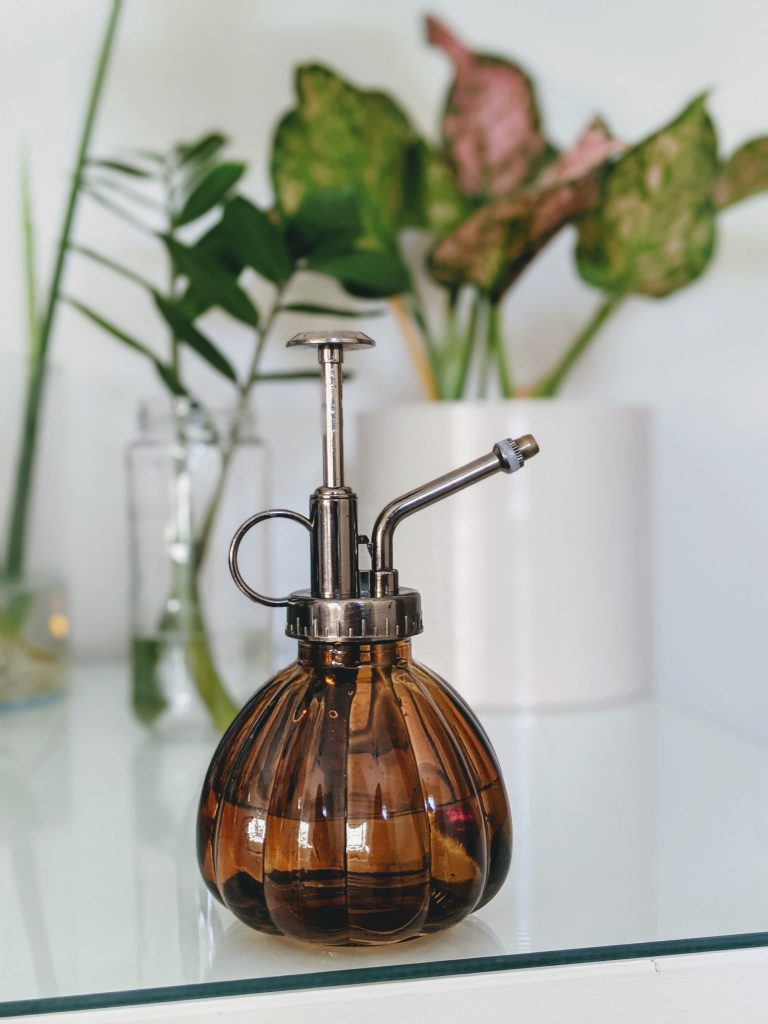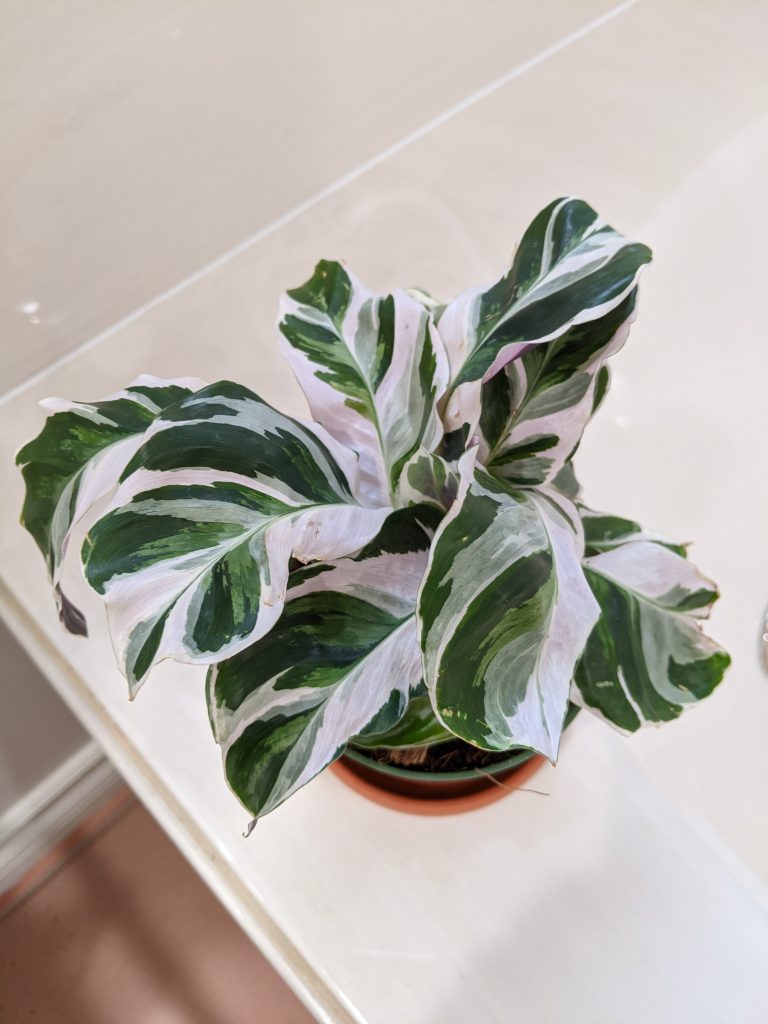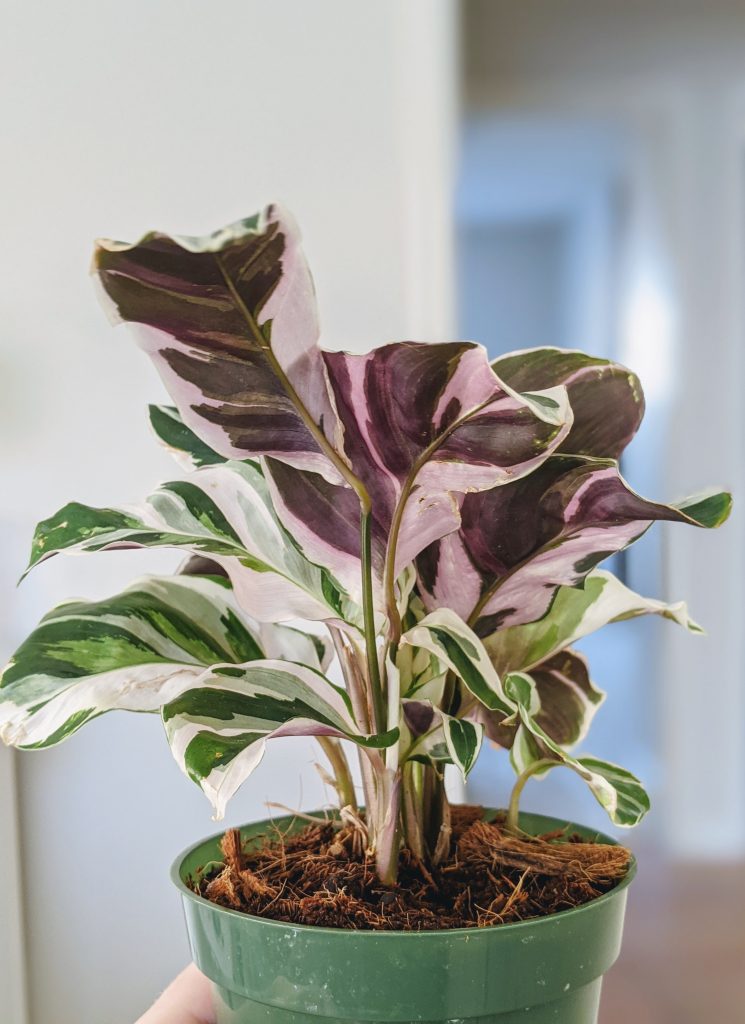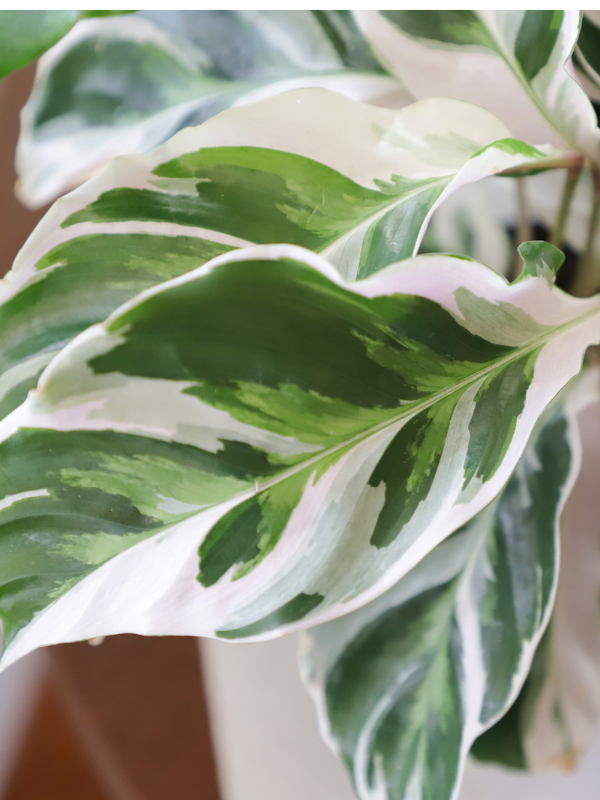Few plants are as beautiful as the White Fusion Calathea – its gorgeous variegated-painted leaves with purple undersides make it pop like a watercolor painting. However, they can be considered a bit of a diva in the plant world.
Caring for your White Fusion Calathea will require you to be a little more attentive than your other houseplants, but as long as it gets enough humidity and stays away from direct sunlight, you should be able to keep it happy and alive.
As an added bonus, these plants are safe for pets.
This post contains affiliate links, which means I may make a small commission if you click through and make a purchase.
Humidity – it Needs it!
The number one thing you need to know about owning a Calathea White Fusion is that they love humidity. Not only do they love it, they need it to survive.
This is the perfect bathroom plant as it will thrive in that type of environment, provided there’s enough filtered light.
If you can’t keep it in the bathroom, you have a few options for ensuring it gets enough humidity.
Use a Humidifier
If you’re not keeping it in the bathroom, you can’t own a Calathea without using a humidifier. It just won’t survive.
If it’s not getting enough humidity, the leaves will be in a constant state of crispy edges and it will eventually succumb to being too dry all the time.
This is one of the best plant humidifiers on Amazon right now as it’s pretty quiet and holds a good amount of water for being so compact (there’s a reason why it’s one of the highest rated).
Or Build a Humid Environment

If you don’t have a humidifier, you can still try to give it the humidity it needs and supplement it with positive vibes or prayers. First, place it in a cluster with other tropical and humid-loving plants.
By grouping them together they will create their own little humidity zone. However, this won’t be enough.
You should still mist them every day or several times a week. When you mist, do it from below and not above.
Here’s a link to the plant mister I use (pictured below).

Additionally, placing them on top of a tray with pebbles and water will also release added humidity.
Another great way to give them extra humidity is to place it under a garden cloche or dome (Beauty and the Beast style).
Not only does this help create a nice little humid environment, it puts your plant on display!
Water Needs
Don’t Let it Sit in Water But Don’t Let it Dry Out

These plants don’t like to miss a watering. Ideally, as soon as the top inch of soil is dry, it’s time for a drink.
This plant prefers less water more often, instead of a big soak every once in a while. Never soak them.
You can expect to water it about once every 5-10 days depending on how much light and humidity it gets.
Keeping it evenly moist is the perfect way to think about how much water it needs.
Oh, and don’t let droplets of water sit on the leaves. They can’t handle heavy amounts of moisture on the delicate foliage.
Use Distilled or Filtered Water Only
Of most importance though, is to use distilled, filtered or rain water as the foliage does not do well from chemicals found in tap water.
This is usually what causes the edges to crisp up and eventually turn brown and die off (which eventually leads to an unhealthy plant).
If you’ve been thinking about getting a water distiller anyway, all of your plants will benefit from the cleanest water possible.
As an added bonus, using distilled water in your humidifier means you’ll have to clean it much less from lack of calcium and mineral build up.
I recommend this highly rated countertop water distiller from Amazon. It holds a good amount of water (a gallon), while still being compact and portable.

Soil Requirements
While these plants love moisture, it doesn’t necessarily mean they like to sit in wet or moist soil. Use a high quality potting soil – no Miracle Grow whatsoever (often the cause of gnats).

I’ve had good luck with Fox Farm products (easily found on Amazon).
Your soil mix should be well draining and aerated, so I usually add in a bit of peat moss and either perlite or pumice and coco coir (which is basically coconut fibre).
This mix from Viagrow is perfect because you get a big bag of perlite and coco coir already mixed together.
Your Calathea will be much happier with a mix like this instead of straight, regular potting soil.
Light Needs: Bright, but Indirect

This type of calathea loves bright, indirect light or diffused sunny light. Think of a greenhouse or garden centre where the roof is light-permeable but not completely clear.
A window that produces either soft morning light or gentle evening sun is ideal. My setup is in the bathroom with a west facing window, but it’s covered with an opaque film to diffuse the light.
And since the white variegation is extra sensitive, it’s important to keep it away from direct sun or else the leaves will burn.
They can usually tolerate lower light conditions but over time, the variegation will fade or won’t be as pronounced.
However, you’ll have better luck in lower light conditions compared to hot sun (directly in front of a south facing window if you’re in the northern hemisphere).
Since they originate from the tropical floors of the rainforest, they tend to prefer indirect and medium light since other plants above them protect them from the hot sun.
Since these plants are fussy about light, a grow light can help in the winter months. It also makes it much easier to give it consistent lighting.
Just be careful not to place your plant directly under the bulbs – ideally 18-24 inches above is perfect.
Grab this grow light from Amazon for under $40. It will save you a few headaches and you can set the timer function for how many hours per day to keep them on (I suggest 12 hours).
But it also turns on automatically after a 24 hour cycle, so it’s completely hassle free.

Repotting Tips
Use a Plastic Pot
These are one of the rare plants that don’t like to be in terracotta or clay pots.
These types of pots whisk away or absorb too much moisture, and calatheas like to be watered as soon as they become slightly dry.
Whichever pot you do choose, make sure there are drainage holes.
Don’t Disturb the Roots
This is a delicate plant, all the way down to its roots. When you need to repot it, take extreme care to not touch, disturb, look at or even breathe on the roots!
Unlike other plants who enjoy having their roots tickled before going into a new pot and soil, the White Fusion’s root ball should be left alone.
Use a nursery pot to make a mold in the new soil and then gently place your Calathe inside.
Common Problems and Troubleshooting
Not looking so healthy? If you think your Calathea White Fusion is dying, the biggest culprit is typically because it’s not getting enough humidity and too much direct sunlight.
You can usually revive them by cutting the plant down to the stems and giving it a good foundation to start over.
But since this is a finicky plant, let’s dive deeper into specific problems and how to fix them.
Pests You Might Encounter
Calathea White Fusions are a magnet for spider mites. If you have them, you’ll notice tiny white specks or little stringy cobwebs on the undersides of the leaves.
I recommend inspecting the foliage once a week (minimum) as you’ll want to catch these little buggers right away.
If they do show up, you can gently wipe or spray all the leaves with a mix of very diluted neem oil with water and a small amount of dish soap or diluted rubbing alcohol.
Honestly, just go straight for the neem oil as it’s the only thing that truly works against bugs on your Calathea. I’ve tried everything else (even buying insecticide sprays), and nothing compares.
Make sure to get all of the stems by using a q-tip. You may also have to prune some of the leaves with a bigger infestation, and that’s ok.
Crispy Edges and Browning Leaves

Browning leaves around the edges and sometimes in the middle often occurs when your Calathea White Fusion is not getting enough humidity. You will likely also encounter this in the first few days after you’ve brought it home as it adjusts to its new space.
Try upping the humidity and giving it the perfect amount of water when it needs it. If the leaves are old growth, you can usually cut them back if they’re looking unsightly to allow for new growth to come through.
The other reason for crispy or brown edges could also be burn from tap water (which is usually treated). Always avoid tap water and stick to distilled or filtered water for the white fusion Calathea.
Dry or Curling Leaves
Leaves on a Calathea that feel dry, brittle or are curling means it’s not getting nearly enough humidity.
To fix this, you should trim off the curling leaves that are in really bad shape and immediately bring your plant into your bathroom or place it by a humidifier with other plants surrounding it.
Depending how many leaves were curling and what you had to cut off, it could take about a month of being a properly humid environment to bounce back.
You can also put it in a makeshift greenhouse by placing a clear plastic bag over it or something to create a humidity dome.
The added humidity will help ease it into its new surroundings if you’ve just brought it home from the greenhouse or received it by mail.
Good luck! Once you dial in the perfect conditions for your Calathea white fusion, it will be a fierce grower and one of the most rewarding plants you will ever own.

Love this plant but can’t manage to keep it alive? Grab some beautiful calathea white fusion stickers or a stunning painting from Etsy.
Stay Green!


Hi, Wichita plant humidifier you recommanded? The link dont work for me..
Thank you very much!!
Oh no, sorry about that! The link is fixed if you try clicking it again it should work. It’s the GENIANI on Amazon. It’s on sale right now too!